The future of the many diasporas which already characterize our present

I was all ready to summarise a post about an internet of many autonomous communities, but what really caught my eye was an article the author links to from 2017.
I’ve already referenced Episode #324 (“What’s Good for the Goose”) of Dan Carlin’s Common Sense podcast this week, and will do so again in relation to this. We’re entering a point in history where the assumptions made at the founding of nation states are being challenged by the digital technologies that allow instant communication between continents.
Ada Palmer is a novelist and historian, whose award-winning Terra Ignota series explores a future of borderless nations. If we stop and think for a moment, those who work from home and don’t have much of a geo-specific social life (🙋), can already choose to live quite differently to their neighbours. I can only seeing that becoming even more the case over time.
What if citizenship wasn’t something we’re born with, but something we choose when we grow up? In the Terra Ignota future, giant nations called “Hives” are equally distributed all around the world, so every house on a block, and even every person in a house, gets to choose which laws to live by, and which government represents that individual’s views the most. It’s an extension into the future of the many diasporas which already characterize our present, since increasingly easy transportation and communication mean that families, school friends, social groups, ethnic groups, language groups, and political parties are already more often spread over large areas than residing all together. In this future each of those groups can be part of one self-governing nation, with laws that fit their values, even while all living spread over the same space.
Source & image: The Reactor
We create more than ever, but it weighs nothing
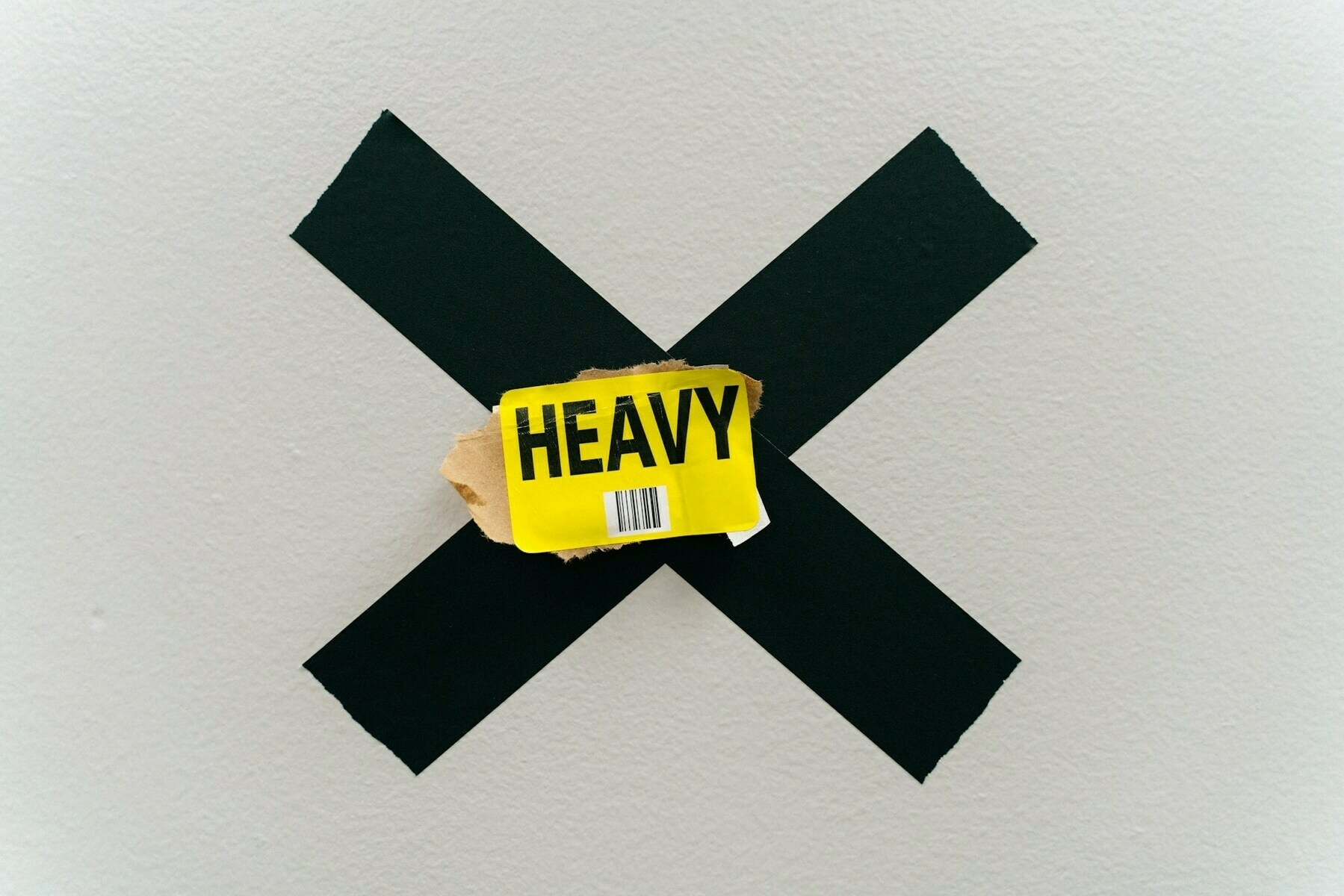
I discovered this post by Dougald Hine via Warren Ellis, which in turn links to Anu’s exhortation to ‘make something heavy’.
The identification of people being ‘pre-heavy thing’ or ‘post-heavy thing’ is an interesting concept. Perhaps I need to think about my next heavy thing?
If something is heavy, we assume it matters. And often, it does. Weight signals quality, durability, presence, permanence.
[…]
We accept this in the physical world.
But online, we forget.
[…]
The modern makers’ machine does not want you to create heavy things. It runs on the internet—powered by social media, fueled by mass appeal, and addicted to speed. It thrives on spikes, scrolls, and screenshots. It resists weight and avoids friction. It does not care for patience, deliberation, or anything but production.
It doesn’t care what you create, only that you keep creating. Make more. Make faster. Make lighter. (Make slop if you have too.) Make something that can be consumed in a breath and discarded just as quickly. Heavy things take time. And here, time is a tax. And so, we oblige—everyone does. We create more than ever, but it weighs nothing.
[…]
Creation isn’t just about output. It’s a process of becoming. The best work shapes the maker as much as the audience. A founder builds a startup to prove they can. A writer wrestles an idea into clarity. You don’t just create heavy things. You become someone who can.
[…]
At any given time, you’re either pre–heavy thing or post–heavy thing. You’ve either made something weighty already, or you haven’t. Pre–heavy thing people are still searching, experimenting, iterating. Post–heavy thing people have crossed the threshold. They’ve made something substantial—something that commands respect, inspires others, and becomes a foundation to build on. And it shows. They move with confidence and calm. (But this feeling doesn’t always last forever.)
Source: Working Theorys
Image: Keagan Henman
The vaunted first amendment guaranteeing free speech has become a bitter and twisted joke

As I’ve seen other post about, there’s no easy way to calculate the impact and lost value of the research that won’t be done, the breakthroughs that won’t be made, and the collaborations that won’t happen as a result of the oligarchy currently taking over the US political system.
In this post, Prof. Christina Pagel gives just one small example of the self-censorship ‘just in case’ that will be happening everywhere. I didn’t travel to the US last year because it felt like an unsafe to visit; I sure as hell ain’t going this year.
Relatedly, I’d highly recommend listening to Episode #324 (“What’s Good for the Goose”) of Dan Carlin’s Common Sense podcast as it puts current events in a wider context.
A colleague and I would like to write an academic paper on the potential impact of US funding cuts to global health programmes. Our ideal co-author is an international expert newly based in the US, and they would like to do it. But we are all worried that doing so will expose them to the risk of having their academic visa cancelled, being detained and eventually deported - no matter how solid the science and how academic and dry our language. We are especially fearful because they are brown.
My colleagues who have been writing about the new administration, or the situation in Gaza, in academic journals, on substack or on social media are cancelling work trips to the US. I too would not feel safe to go now, given how openly I have criticised the administration. Even a 1% chance of being denied entry or shipped to a detention centre is too high.
When I said these words out loud to my husband today I had to stop for a moment to let it sink in. Foreign scientists in the US are scared to publish anything perceived as critical for fear of being bundled off the street to a detention centre. Foreign scientists abroad are scared to go to the US because they have voiced criticism of the state. The US is actively cracking down on perceived dissenters and foreigners are the most vulnerable to arbitrary detention and lack of due legal process. The vaunted first amendment guaranteeing free speech has become a bitter and twisted joke.
Source: Diving into Data & Decision making
Image: Floris Van Cauwelaert
The Ghibli crisis is just the beginning
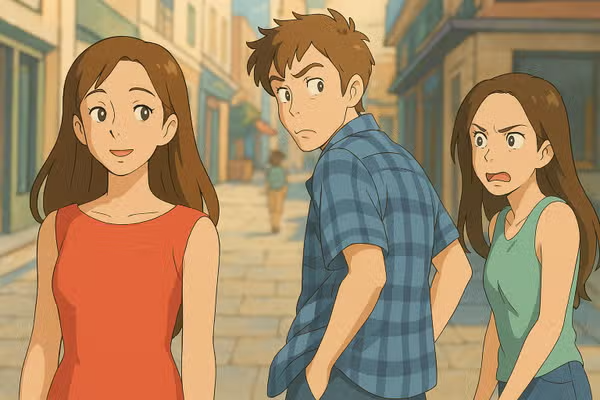
As I’ve argued many times, including just last week appending ‘literacy’ to a word is an attempt at control. It’s a power move, either intentionally or unintentionally. So, for example, with the work that I’ve been kicking off around AI Literacy recently with the BBC, it’s interesting to see the way that, for example, Big Tech wants to define it compared to, say, academics.
In this post, Jay Springett introduces the term ‘context literacy’ but doesn’t really define what it means. I don’t doubt that what he identifies in the post isn’t a set of important skills and competencies, but is it a ‘literacy’? Is it a way of metaphorically ‘reading’ and ‘writing’? Or is it just a way of understanding and making sense of the world?
I definitely agree that we’re in the midst of another culture war that, perhaps more than ever before, is predicated on a lack of shared context. I’ve started watching the Contrapoints video I shared recently about conspiracism, which I think is very closely related to this.
The Ghibli crisis is just the beginning. Focusing on the outputs alone misses the point.
So how do we respond?
We must recognise that revolution is not over. We are in the Information Age.
We must cultivate context literacy and we must maintain a distinction between the infrastructure and the experience, between machine and meaning.
We are living through a moment that future historians may describe as a cultural rupture. A context war. How this plays out will shape new definitions of truth, authorship, creativity, and trust, perhaps for centuries to come.
The question is not whether this will happen.
It already is.
Source: thejaymo
Organisations will need to change their analogies

Ethan Mollick reports on a study last summer with 776 professionals at Procter and Gamble. The findings, pretty obviously, show that working with AI boosts performance, but also that working in teams is just as effective as working with AI. Teams working with AI “were significantly more likely to produce… top-tier solutions.”
What’s interesting to me, though, is the emotional aspect of all this. Unless you’ve done work around, say, nonviolent communication and Sociocracy it’s likely to that you experience regular unprocessed negative emotions around work. Especially if you work in a hierarchical setting.
Generative AI can be particularly good at helping you think more objectively about work — as being something that you have ideas and thoughts about, rather than emotions. At least, it does for me. Note that I definitely think that you should bring your full self to work, it’s just that unhelpful negative emotions can sometimes creep in to our relationships with other humans, especially around the validation (or otherwise) of ideas.
For me, the sweet spot is working with people I know, respect, and trust (i.e. my colleagues at WAO) and using generative AI to augment our collaboration.
A particularly surprising finding was how AI affected the emotional experience of work. Technological change, and especially AI, has often been associated with reduced workplace satisfaction and increased stress. But our results showed the opposite, at least in this case.
People using AI reported significantly higher levels of positive emotions (excitement, energy, and enthusiasm) compared to those working without AI. They also reported lower levels of negative emotions like anxiety and frustration. Individuals working with AI had emotional experiences comparable to or better than those working in human teams.
While we conducted a thorough study that involved a pre-registered randomized controlled trial, there are always caveats to these sorts of studies. For example, it is possible that larger teams would show very different results when working with AI, or that working with AI for longer projects may impact its value. It is also possible that our results represent a lower bound: all of these experiments were conducted with GPT-4 or GPT-4o, less capable models than what are available today; the participants did not have a lot of prompting experience so they may not have gotten as much benefit; and chatbots are not really built for teamwork. There is a lot more detail on all of this in the paper, but limitations aside, the bigger question might be: why does this all matter?
[…]
To successfully use AI, organizations will need to change their analogies. Our findings suggest AI sometimes functions more like a teammate than a tool. While not human, it replicates core benefits of teamwork—improved performance, expertise sharing, and positive emotional experiences. This teammate perspective should make organizations think differently about AI. It suggests a need to reconsider team structures, training programs, and even traditional boundaries between specialties. At least with the current set of AI tools, AI augments human capabilities. It democratizes expertise as well, enabling more employees to contribute meaningfully to specialized tasks and potentially opening new career pathways.
The most exciting implication may be that AI doesn’t just automate existing tasks, it changes how we can think about work itself. The future of work isn’t just about individuals adapting to AI, it’s about organizations reimagining the fundamental nature of teamwork and management structures themselves. And that’s a challenge that will require not just technological solutions, but new organizational thinking.
Source: One Useful Thing
Image: Igor Omilaev
Once you become aware of Hyperlegibility, you see it everywhere

I think the author of this article, Packy McCormick, has essentially discovered “working openly.” But, I guess, the twist is that it’s doing so in a way that makes your ideas accessible and understandable to as many people as possible.
It’s interesting doing this in an age of AI, because (as McCormick) does, you can half-remember something, type it into an LLM, and have it find the thing you’re talking about, with sources, extremely quickly.
If ‘hyperlexic’ describes extraordinary reading ability, then let me propose a complementary word for extraordinary readability: Hyperlegible.
Hyperlegibility defines our current era so comprehensively that I was shocked when I googled the term and found only references to fonts.
[…]
Hyperlegibility emerges with game theoretical certainty from each of our desire to win whatever game it is you’re playing. Certainly, it’s a consequence of playing The Great Online Game. In order for the right people and projects to find you, you must make yourself legible to them. To stand out in a sea of people making themselves legible, you must make yourself Hyperlegible: so easy to read and understand you rise to the top.
Once you become aware of Hyperlegibility, you see it everywhere.
[…]
Hyperlegibility isn’t good or bad. It’s neither and both. But it certainly is. Information used to be the highest form of alpha. Now everyone bends over backwards to leak it.
Through a combination of humanity getting ever-better at reading anything and humans becoming ever-more willing to make themselves legible, information is easier to find and understand than it’s ever been.
Source: Not Boring
Image: Egor Myznik
Less anonymity online is not going to make things better

I use the Switzerland-based service Proton for my personal email and VPN, so news that the Swiss government is considering amending its surveillance law isn’t great news.
It looks like the specific thing they’re targeting is the metadata — i.e. not the content of the message, but where it was sent from and to whom. That’s the kind of information that Meta collects when people use WhatsApp. By way of comparison, Proton is more like Signal messenger in they don’t harvest this kind of metadata.
You might wonder why this is important, but putting together a story based on metadata isn’t exactly difficult. And, as is well-attested, if you have enough metadata, you don’t really need the content of the messages.
Consultations are now public and open until May 6, 2025. Speaking to TechRadar, NymVPN has explained how it’s planning to fight against it, alongside encrypted messaging app Threema and Proton, the provider behind one of the best VPN and secure email services on the market.
Authorities' arguments behind the need for accessing more data are always the same – catching criminals and improving security. Yet, according to Nym’s co-founder and COO, Alexis Roussel, being forced to leave more data behind would achieve the opposite result.
“Less anonymity online is not going to make things better,” he told TechRadar. “For example, enforcing identification of all these small services will eventually push to leaks, more data theft, and more attacks on people.”
[…]
“It’s not about end-to-end encryption. They don’t want to force you to reveal what’s inside the communication itself, but they want to know where it goes,” Roussel explains. “They realize the value is not in what is being said but who you are talking to.”.
“The whole point of security and privacy is not being able to link the usage to the person. That’s the most critical thing.” Roussel told TechRadar.
Source: TechRadar
Image: Arturo A
You do not have to participate in the lottery
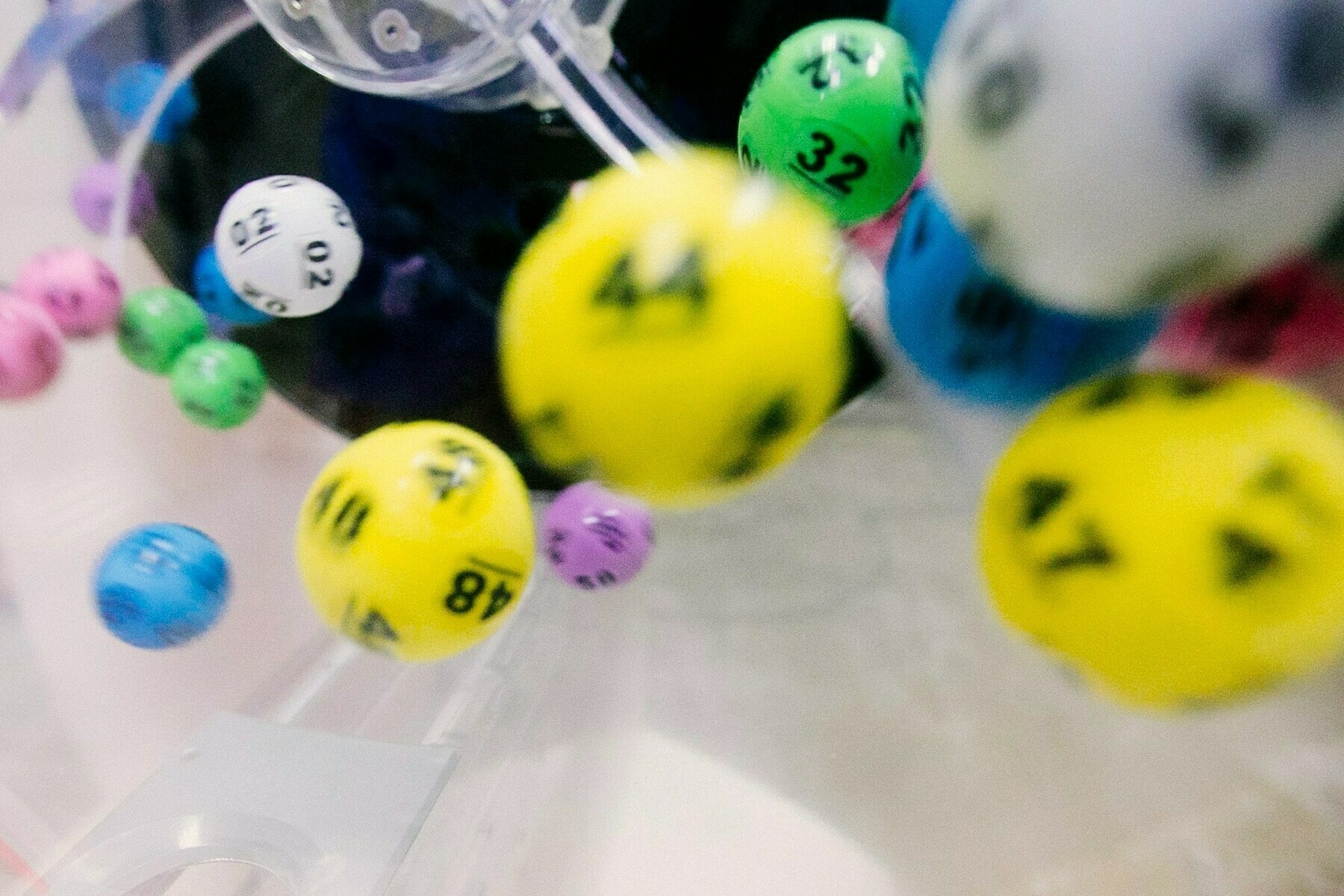
This is the first post I’ve come across from Paras Chopra, and I love the strapline for his blog: “Be passionate about the territory, not the map.” He’s still young, and the overall philosophy of life he outlines here is a touch naive (reminding me of myself at that age) but nevertheless it’s solid advice.
In most modern cultures, direct coercion doesn’t exist. Nobody can make you work harder than you want to. However, with our infinite algorithmic timelines, we’re immersed with indirect coercion.
But, you do not have to participate in the lottery. You can choose to quit. You can decide to not compete. You can choose to not participate in the lottery, where you’d almost likely lose more than you receive in return.
To be clear, this doesn’t mean inactivity. (Life is a game, where inactivity means death.)
Rather, what this implies is something very simple – don’t confuse what gets social approval with what’s right for you. Social approval exists to attract participants in a game that ultimately benefits the collective at the expense of an individual.
[…]
Once you overcome your desire to compete with others, you can actually just sit back and enjoy the outcomes that others compete to produce for you.
[…]
Let others compete hard to let you enjoy these things, while you do what you find most fun. It could be tending to your garden, working at a sensible pace, making coffee, building tiny weird games, or whatever else makes you come alive.
I hear you ask: won’t society collapse if everyone did this? I’d argue the opposite. If everyone did what they find most fulfilling, our net happiness will rise. Artifacts useful to the society will still be produced, except with less anxiety and burnout. People will still write books, but without an intent of it trying to be a bestseller but with an intent of honing and enjoying their craft.
Source: Inverted Passion
Image: dylan nolte
Things have changed

I know Martin Waller from the early days of Twitter when we were both teachers. The ‘Multi’ part of his ‘MultiMartin’ handle is due to his work on multiliteracies, the subject of his postgraduate study. He’s written plenty of papers and spoken at more than a few events.
Martin dropped off my radar a bit, but on reconnecting with him this week, he pointed me towards this post. I think we’re going to see a lot more of this over the next few years. How would Gwyneth Paltrow put it, “conscious decoupling” from online life, maybe?
I’ve… taken the decision to completely remove myself from social media including most online messaging services. I was once an advocate of the use of social media and digital technologies and have published book chapters and spoken at events around the world about it in education. I have made so many wonderful connections and friends over the years on the internet and through social media. However, things have changed. The landscape and current climate can be toxic and dangerous. I’ve stumbled upon comments on Facebook and Instagram which have made me feel sick. I’ve read different messenger channels where comments have ridiculed people for no good reason. There’s also just too much information out there and it isn’t helpful to be exposed to it all, all of the time. It makes it difficult to switch off, think and focus on what matters.
Source: MultiMartin
Image: Chris Barbalis
A bit of composting
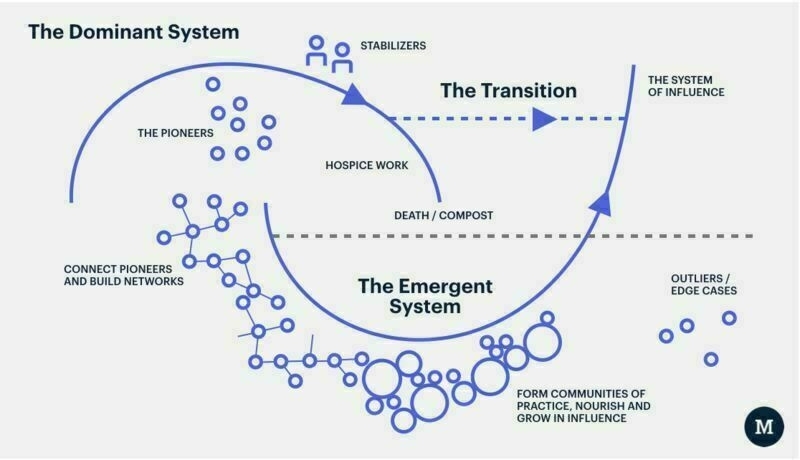
There’s a lot of people thinking about endings at the moment. Not just because we’re getting into the post-Covid era now, but also due to things like the huge swathes of layoffs in the US, and the general economic downturn in the UK and other countries.
Things start and things end. That’s what they do. Change is constant, which is something difficult to get used to. In this post, Tom Watson talks about ‘composting’ which is a key part of the Berkana Institute’s Two Loops model, which he doesn’t actually reference but is extremely relevant.
I’d also say working openly helps with having good endings. The chances are that what has been learned during the project can take root elsewhere, and therefore live on, if people can see into the project. We should treat projects less as raised beds for pretty flowers and more like mycelium networks.
I thought about the social enterprise I had with my dad. I’ve got lots of things wrong in life, but doing that definitely wasn’t one of them. I learned a lot, about caring, kindness, not following the bullshit, and community. It ended, like all organisations do. But I was proud that we were able to financially support a group to continue meeting and chatting, and supporting each other. It wasn’t much, but it was something. And just last year we donated the last of our funds, around £6k, to a charity rewilding in Scotland, where the C for Campbell in my name comes from via my dad.
This felt like a good ending. A bit of composting. But not every organisation can pass on finances at the end, in fact it’s pretty rare, because often the root cause of the ending is money. But that doesn’t mean they don’t have things of value to pass on. They have resources, knowledge and wisdom. And I couldn’t help thinking about all that is lost, again and again when things end.
[…]
[W]e need to think broader about endings and composting. Not just when an organisation ends, but when programmes and projects end. What about all the research reports, the data from projects, the experiments that worked and those that didn’t. What about all that knowledge, what about all that potential wisdom. It’s why we spend time up front cataloguing all the things we do in a project along the way. It’s not perfect, but it’s something.
Source: Tomcw.xyz
Image: Innovation Unit
Discussing misinformation for the purpose of pointing out that it is misinformation
ContraPoints is “an American left-wing YouTuber, political commentator, and cultural critic” with the moniker coming from the fact that her content “often provide[s] counterargument to right-wing extremists and classical liberals.” She “utilizes philosophy and personal anecdotes to not only explain left-wing ideas, but to also criticize common conservative, classical liberal, alt-right, and fascist talking points,” with the videos having “a combative but humorous tone, containing dark and surreal humor, sarcasm, and sexual themes.”
I haven’t watched this yet, partly because I struggle to fit watching videos longer than 10 minutes into my day, and partly because it is absolutely the kind of thing I would watch by myself. The first few minutes are fantastic, I can tell you that much, with the focus being on conspiracy theories and misinformation.
Our current level of discourse, where random jokes are treated like they’re chiseled into stone by a divine hand
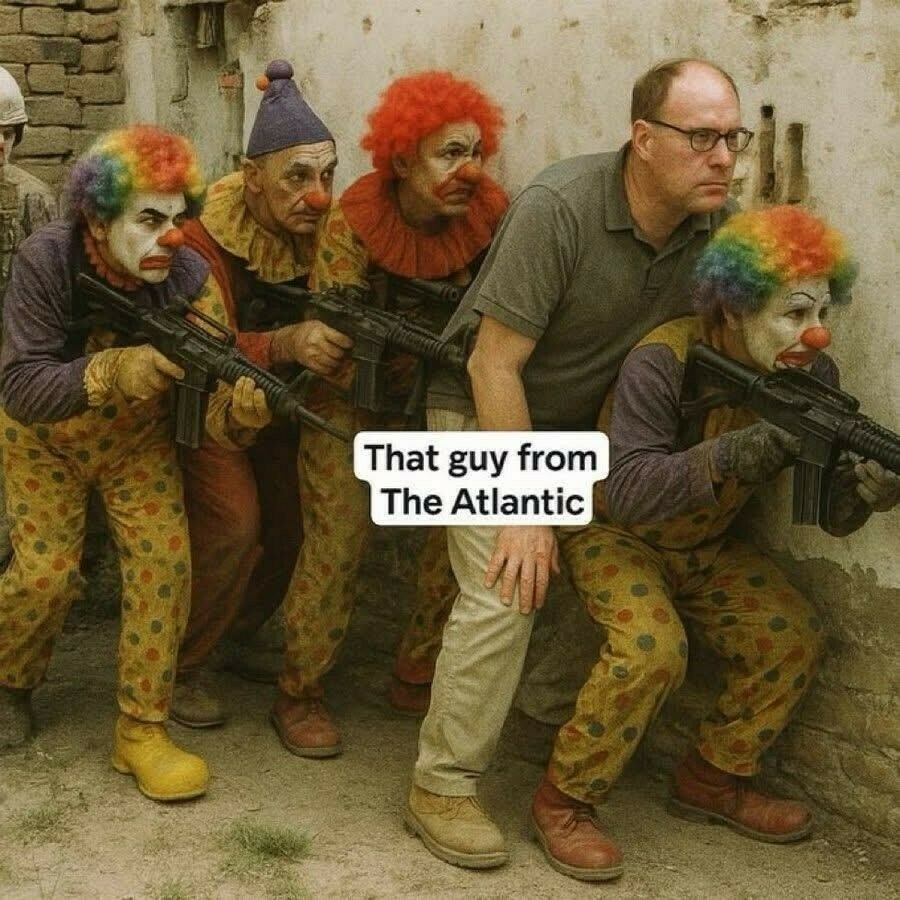
I’m not Very Online™ online enough to be able to understand what’s going on in popular culture, especially when it comes to the business models, politics, and norms behind it. So, thank goodness for Ryan Broderick, who parses all of this for all of us.
In this part of one of his most recent missives, Broderick talks about Barack Obama joining Bluesky, and the history (and trajectory) of people acting like brands, and brands acting like people. He says a lot in these two paragraphs, which in his newsletter he then goes to connect to the recent incident where a reporter from The Atlantic was accidentally added to a White House Signal war-planning group.
We live in interesting times, but mainly flattened times, where nothing is expected to have any more significance than anything else, and is presented to us via little black rectangle. At this point, I feel like I want to write another thesis on misinformation and disinformation in the media landscape. But perhaps it would be too depressing.
Bluesky made a big splash at South By Southwest earlier this month, with CEO Jay Graber delivering the keynote in a sweatshirt making fun of Mark Zuckerberg. When they made the shirt available for sale, it sold out instantly — in large part because it’s the first time ever that regular people have been able to give Bluesky money. The platform started as a decentralized, not-for-profit research effort, specifically trying to avoid the mistakes of Twitter, and before the shirt, it was still funded entirely by investors. Though, as of last year, they’re working on paid subscriptions. The Bluesky team has been swearing up and down that they’re working to avoid the mistakes Twitter/X has made, but if they eventually offer a subscription to Obama that treats his account identically to yours or mine, they’ve already made the most fundamental mistake here. Because the social media landscape Obama helped create, by blending the casual and the official, is the exact same one Bluesky was founded to work against. If a brand is a person, then a person has to be a brand, especially in an algorithmically-controlled attention economy that’s increasingly shifting literally everything about social media towards getting your money. And more importantly, if a government official or group has a social media presence, it has to be both a person and a brand.
And eight years after Obama walked this tightrope all the way to the White House, Donald Trump ran it up the gut. Trump, unfortunately, understands the delirious unreality of the person/brand hybrid better than maybe anyone else on the planet. Well, he might be tied with WWE’s Vince McMahon. But Trump’s first administration established a precedent of treating his tweets as official statements. And more directly than anything I’m blaming Obama for here, Trump sent us on the rollercoaster that just loop-de-looped past “a shitty website is all the transparency the US government needs” a few weeks ago. Now, there’s no difference between a post that’s an executive order, a commercial, or someone saying whatever bullshit is on their mind. In fact, it must serve as all of the above. On one end of this, you get our current level of discourse, where random jokes are treated like they’re chiseled into stone by a divine hand.
Source: Garbage Day
Image: Mastodon (various accounts posted this, couldn’t find the original)
Essentially a checklist of weird Instagram shit

I’m officially middle-aged, so have given up trying to understand under-40s culture. However, it’s still worth studying, especially when it’s essentially algorithmically-determined.
In this article, Ryan Broderick gives the example of Ashton Hall, a fitness influencer:
Hall’s video, which was originally shared to his Instagram page back in February, is essentially a checklist of weird Instagram shit. A dizzying mix of products and behaviors that make no sense and that no normal person would ever actually use or try, either because Hall figured out that they’re good for engagement on his page or because he saw them in other videos because they were good for those creators’ engagement.
And so we have things that people do, and are watched doing, because an inscrutable algorithm has decided that this is what people want to watch. So this is what is served, what people consume, and therefore the content which influencers make more of. And so it goes.
Culture shifts, and not always in good ways. As the Netflix series Adolescence shows, there is a sinister underbelly to all of this. But then that is, in itself weaponised to suggest that some way to fix or solve things is to ban digital devices. Instead of, you know, digital and media literacies.
In terms of physical safety, one of the most dangerous things you can do is laugh at someone who considers themselves hyper-masculine. But this is also the correct response to all of this stuff. It’s ridiculous. So the key is to point out how ridiculous it is to boys and young men, not in a way that condemns other (unless it’s someone like Andrew Tate) but rather just how it doesn’t make any sense.
“Fifteen years ago this routine would get you called gay (or ‘metrosexual’) but is now considered peak alpha male behavior. Something weird has shifted,” influencer and commentator Matt Bernstein wrote of Hall’s video. And, yes, something has shifted. Which is that these people know that there are a lot of very sad men that are going to get served their videos, and they’re fully leaning into it.
Guys like Hall are everywhere, with vast libraries of masculinity porn meant to soothe your sad man brain. Nonsexual (usually) gender-based content, like the trad wives of TikTok, targets your desires the same way normal porn does. Unrealistic and temporarily fulfilling facsimiles of facsimiles that come in different flavors depending on what you’re into. There’s a guy who soaks his feet in coke. A guy who claims he goes to a gun range at six in the morning. A guy who brings a physical book into his home sauna. A guy who’s really into those infrared sleep masks and appears to have some kind of slave woman who has to bow to him every morning before he takes it off. A guy who does the face dunk with San Pellegrino, rather than Saratoga. An infinitely expanding universe of musclemen who want to convince you that everything in your life can be fixed if you start waking up at 4 AM to journal, buy those puffy running shoes, live in a barely furnished Miami penthouse, have no real connections in your life — especially with women — and, of course, as Hall tells his followers often on Instagram, buy their course or ebook or seminar or whatever to learn the real secrets to success.
And I’ve been surprised that this hasn’t come up more amid our current national conversation about men. Because this is the heart of it. There are a lot of very large, very dumb men who want you to sleep three hours a night and invest in vending machines and do turmeric cleanses and they all know that every man in the country is one personal crisis away from being being algorithmically inundated by their videos. And as long as that’s the case, there’s really nothing we can do to fix things.
Source: Garbage Day
Image: Screenshot of video from Ashton Hall, fitness influencer
This confirms all my prejudices, I am pleased to say
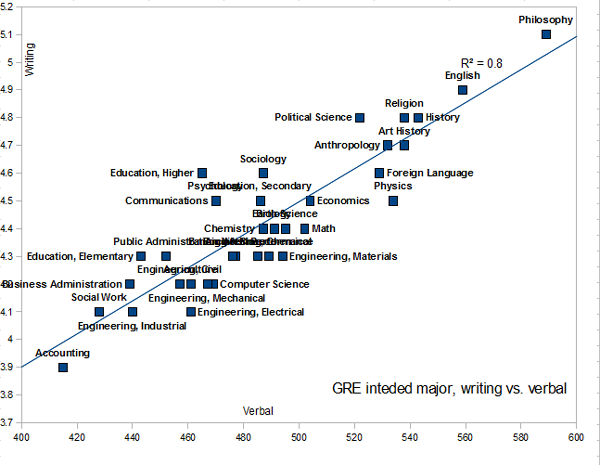
I had a much-overdue catch-up with Will Bentinck earlier today, during which I discovered he holds a first-class degree in Philosophy! Obviously, Philosophy graduates are legimtimately The Best™ so my already high opinion of him scaled new heights.
Talking of scaling new heights, check out what happens when you plot Philosophy graduates' verbal against writing scores. All of which backs up my opinion that a Humanities degree is, in general, the best preparation for life. And, more specifically, it helps you with levels of abstraction that are going to be even more relevant and necessary in our AI-augmented future…
This data suggests (but falls a long way short of establishing) that if we want to produce graduates with general, across-the-board smarts, physics and philosophy are disciplines to encourage [and possibly also that accountancy and business administration should be discouraged (this confirms all my prejudices, I am pleased to say!)].
Source: Stephen Law
Just seek to understand, and remember we understand a lot by doing

After some success ‘vibe coding’ both Album Shelf and a digital credentials issuing platform called Badge to the Future, I’ve run a couple of sessions called ‘F*ck Around and Find Out’ relating to AI. I also knocked up a career discovery tool.
I’m sharing all of these links because I think people should be experimenting with generative AI to see what it can do and where the ‘edges’ are. I said as much when recording a episode for Helen Beetham’s imperfect offerings podcast which I’m hoping will come out soon.
Discussing some of this on the All Tech is Human Slack, Noelia Amoedo shared this post from her blog. After experimenting with other tools, she like me has settled on Lovable. I used the $50/month tier last month as I ran out of prompts on the $20/month level. You do get some for free.
What I think is explicit in Noelia’s post is the potential decentralisation of power this enables. What is implicit is that it takes curiosity to do this. As I signed off Helen’s podcast as saying (spoiler alert!) “my experience has been that most people are intellectually lazy, extremely uncurious, and want to take something off the shelf, implement it without too much thought, and be considered ‘innovative’ for doing so.”
You might say that being “intellectually lazy” is using AI. But I disagree. So long as you’re not just getting it to answer an essay question or come up with a some trite, fascist-adjacent imagery, then interacting with it involves choice (which model? what prompt?) and creativity.
I settled on Lovable, a Swedish company. The fact that they were European may have influenced my decision… or did I realize that later? I did subscribe, but only for a month (I seem to have learned to moderate my impulses just a bit). I took advantage of a business trip to write the code for my website, and I worked on it between meetings over two days. It must have taken about four or five hours overall, but it could have been done in one or two hours if the content had been ready when I started. It is possibly longer than what it would have taken with WordPress, I admit, but it gave me so much flexibility! I also own the code and I can take it anywhere. I did have to figure out some “techy” things, like how to turn the JavaScript7 code into something that I could upload to my hosting service, but Lovable was right there to provide any instructions I needed, and I have to confess I enjoyed bossing him (it!!!) around to change things here or there.
Asking for something in your own words and getting it done instantly almost feels like magic, just as graphical user interfaces felt magical when we were used to command lines. And if graphical user interfaces opened the digital world to so many people who were not digital till then, conversational user interfaces are already doing the same so much faster.
[…]
I can’t help but wonder: Could this be a way to decentralize and give digital power back to the people? Could small digital companies have a better shot at long-term survival in the new ecosystem that rises, or will power end up even more concentrated? Will this bring tighter software thanks to expert computer scientists empowered by AI, or will the digital space degrade due to a bunch of “spaghetti code” that is difficult to understand and maintain? Will no-code builders like Replit or Lovable bring people closer to understanding code, or will they have the opposite effect?
I have no answers, but let me just say that my curiosity brought me closer to the code than I had ever been in 25 years, and I’d encourage you to do the same: get just a bit closer from wherever your starting point may be. Just seek to understand, and remember we understand a lot by doing. The world is changing very quickly, and the new AI wave will most likely affect you whether you want it or not. You may as well understand what’s coming, and as we would say in Spain, take the bull by the horns.
Source: Noel-IA’s Substack
Image: Snapcat by Oleksandra Mukhachova & The Bigger Picture
The first fully-open LLM to outperform GPT3.5-Turbo and GPT-4o mini

Thanks to Patrick Tanguay who commented on one of my LinkedIn updates, pointing me towards this post by Simon Willison.
Patrick was commenting in response to my post about ‘openness’ in relation to (generative) AI. Simon has tried out an LLM which claims to have the full stack freely available for inspection and reuse.
He tests these kinds of things by, among other things, getting it to draw a picture of a pelian riding a bicycle. The image accompanying this post is what OLMo 2 created (“refreshingly abstract”!) To be fair, Google’s Gemma 3 model didn’t do a great job either.
It’s made me think about what an appropriate test suite would be for me (i.e. subjectively) and what would be appropriate (objectively). There’s Humanity’s Last Exam but that’s based on exam-style knowledge which isn’t always super-practical.
mlx-community/OLMo-2-0325-32B-Instruct-4bit (via) OLMo 2 32B claims to be “the first fully-open model (all data, code, weights, and details are freely available) to outperform GPT3.5-Turbo and GPT-4o mini”.
Source: Simon Willison’s Weblog
Everyone is at least a little bit weird, and most people are very weird

I like all of what I’ve read of Adam Mastroianni’s work, but I love this. I’d enthusiastically encourage you to go and read all of it.
Mastroianni discusses a time when he went for a job interview as a professor, realising that he had a couple of choices. He could be himself, or wear a mask. Ultimately, he decided to be himself, didn’t get the job, but everything was fine.
From there, he talks about the some of the benefits and drawbacks of conformance as a species, noting that taking the mask off is incredibly liberating. I know this from experience, as it was the exact advice given to me by my therapist in 2019/20 and, guess what? Afterwards some people thought I was an asshole. But then, so did people before. At least I know where I’m at now.
[H]istorically, doing your own thing and incurring the disapproval of others has been dangerous and stupid. Bucking the trend should make you feel crazy, because it often is crazy. Humans survived the ice age, the Black Plague, two world wars, and the Tide Pod Challenge. 99% of all species that ever lived are now extinct, but we’re still standing. Clearly we’re doing something right, and so it behooves you to look around and do exactly what everybody else is doing, even when it feels wrong. That’s how we’ve made it this far, and you’re unlikely to do better by deriving all your decisions from first principles.
Maybe there are some lucky folks out there who are living Lowest Common Denominators, whose desires just magically line up with everything that is popular and socially acceptable, who would be happy living a life that could be approved by committee. But almost everyone is at least a little bit weird, and most people are very weird. If you’ve got even an ounce of strange inside you, at some point the right decision for you is not going to be the sensible one. You’re going to have to do something inadvisable, something alienating and illegible, something that makes your friends snicker and your mom complain. There will be a decision tucked behind glass that’s marked “ARE YOU SURE YOU WANT TO DO THIS?”, and you’ll have to shatter it with your elbow and reach through.
[…]
When you make that crazy choice, things get easier in exactly one way: you don’t have to lie anymore. You can stop doing an impression of a more palatable person who was born without any inconvenient desires. Whatever you fear will happen when you drop the act, some of it won’t ultimately happen, but some will. And it’ll hurt. But for me, anyway, it didn’t hurt in the stupid, meaningless way that I was used to. It hurt in a different way, like “ow!…that’s all you got?” It felt crazy until I did it, and then it felt crazy to have waited so long.
Source: Experimental History
Image: JOSHUA COLEMAN
Taking natural-looking motion to yet another level
The above Boston Dynamics video is currently doing the rounds, with yet more human-like movement. It’s pretty impressive.
The usual response to this kind of thing is amusement tinged with fear. But, as with everything, it’s the systems within which these things exist that are either problematic or unproblematic. For example, we have zero problem with these being part of a research facility; we might have reservations if they were used in military situations. But then, we use drones in combat these days?
All of which to say: there are many dangerous and scary things in the world, and there are many dangerous and scary people in the world. The way we deal with these in a sustainable and low-drama way is through policies and process. So, unless I have reason to believe otherwise, I’m going to imagine the robots in these videos doing the jobs that currently require humans doing things that might endanger their health, such as rescuing people from burning buildings, inspecting nuclear reactors, and even doing very repetitive tasks under time pressure in warehouses.
Yes, AI and robots are going to replace jobs. No, it’s not the end of the world.
[L]est we forget who’s been at the forefront of humanoid research for more than a decade, Boston Dynamics has just released new footage of its stunning Atlas robot taking natural-looking motion to yet another level.
[…]
As humans learn to walk, run and move in the world, we start anticipating little elements of balance, planning ahead on the fly in a dynamic and changing situation. That’s what we’re watching the AIs learn to master here.
The current explosion in humanoid robotics is still at a very early stage. But watching Atlas and its contemporaries do with the physical world what GPT and other language models are doing with the world of information – this is sci-fi come to life. […]
These things will be confined to factories for the most part as they begin entering the workforce en masse, but it’s looking clearer than ever that humans and androids will be interacting regularly in daily life sooner than most of us ever imagined.
Source: New Atlas
In many ways, Silicon Valley looks less like capitalism and more like a nonprofit

Yes, yes, more AI commentary but this is a really good post that you should read in its entirety. I’m zeroing on one part of it because I like the analogy of Silicon Valley looking less like capitalism and more like the nonprofit space.
TL;DR: just as we haven’t got fully self-driving cars yet, or any of the other techno-utopian/dystopian technology that was promised years ago, so we’re not about to all be immediately replaced by AI.
Yes, it’s going to have an impact. And, of course, lazy uncurious people are going to use it in lazy uncurious ways. But, the way I see it, we should be more interested in the structures behind the AI bubble. Because although there is useful tech in there, it remains a bubble.
In many ways, Silicon Valley looks less like capitalism and more like a nonprofit. The way you get rich isn’t to sell products to consumers, because you’re likely giving away your product for free, and your customers wouldn’t pay for it if you tried to charge them. If you’re a startup, and not FAANG, the way you pay your bills is to convince someone who’s already rich to give you money. Maybe that’s a venture capital investment, but if you want to get really rich yourself, it’s selling your business to one of the big guys.
You’re not selling a product to a consumer, but selling a story to someone who believes in it, and values it enough to put money towards it. That story of how you can change the world could be true, of course. Plenty of nonprofits have a real and worthwhile impact. But it’s not the same as getting a customer to buy a product at retail. Instead, you’re selling a vision and then a story of how you’ll achieve it. This is the case if you go to a VC, it’s the case if you get a larger firm to buy you, and it’s the case if you’re talking ordinary investors into buying your stock. (Tesla’s stock price is plummeting because Musk’s brand has made Tesla’s brand toxic. But Tesla’s corporate board can’t get rid of him, because investors bought Tesla’s stock—and pumped it to clearly overvalued levels—precisely because they believe in the myth of Musk as a world-historical innovator who will, any day now, unleash the innovations that’ll bring unlimited profits.) (Silicon Valley has, however, given us seemingly unlimited prophets.)
What this means for AI is that, even if the tech bros recognized how far their models are from writing great fiction or solving the trolley problem, they couldn’t admit as much, because it would deflate the narrative they need to sell.
Source: Aaron Ross Powell
Image: Maxim Hopman
Dozens of small internet forums have blocked British users or shut down as new online safety laws come into effect
You won’t see me linking to the Torygraph often, but in this case I want to show that it’s not just left-leaning very online people who are concerned about the UK’s Online Safety Act (2023) which came into force this week.
Neil Brown, a lawyer whose specialities include intenet, telecoms, and tech law, has set up a site collating information provided by Ofcom, the communications regulator. As far as I understand it, Ofcom couldn’t have done a worse job in conjuring up fear, uncertainty, and doubt. There are online forums and other spaces shutting down just in case, as the fines are huge.
This is an interesting time for WAO to be starting work with Amnesty International UK on a community platform for activists. Yet more unhelpful ambiguity to traverse. Yay.
Dozens of small internet forums have blocked British users or shut down as new online safety laws come into effect, with one comparing the new regime to a British version of China’s “great firewall”.
Several smaller community-led sites have stopped operating or restricted services, blaming new illegal harms duties enforced by Ofcom from Monday.
[…]
Britain’s Online Safety Act, a sprawling set of new internet laws, include measures to prevent children from seeing abusive content, age verification for adult websites, criminalising cyber-flashing and deepfakes, and cracking down on harmful misinformation.
Under the illegal harms duties that came into force on Monday, sites must complete risk assessments detailing how they deal with illegal material and implement safety measures to deal with the risk.
The Act allows Ofcom to fine websites £18m or 10pc of their turnover.
The regulator has pledged to prioritise larger sites, which are more at risk of spreading harmful content to a large number of users.
“We’re not setting out to penalise small, low-risk services trying to comply in good faith, and will only take action where it is proportionate and appropriate,” a spokesman said.
Source: The Telegraph
Image: Icons8 Team